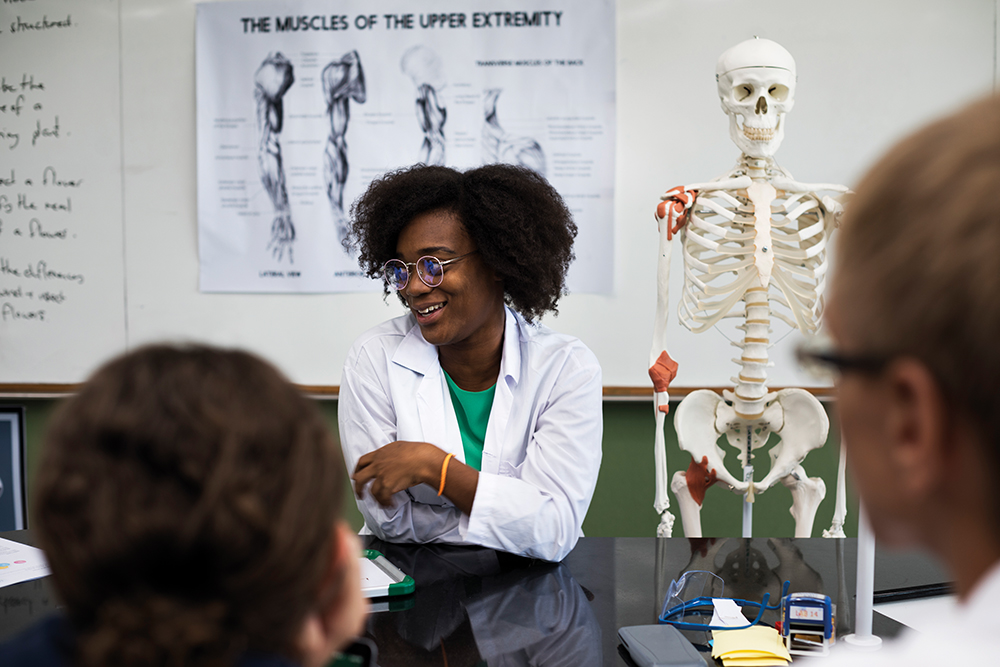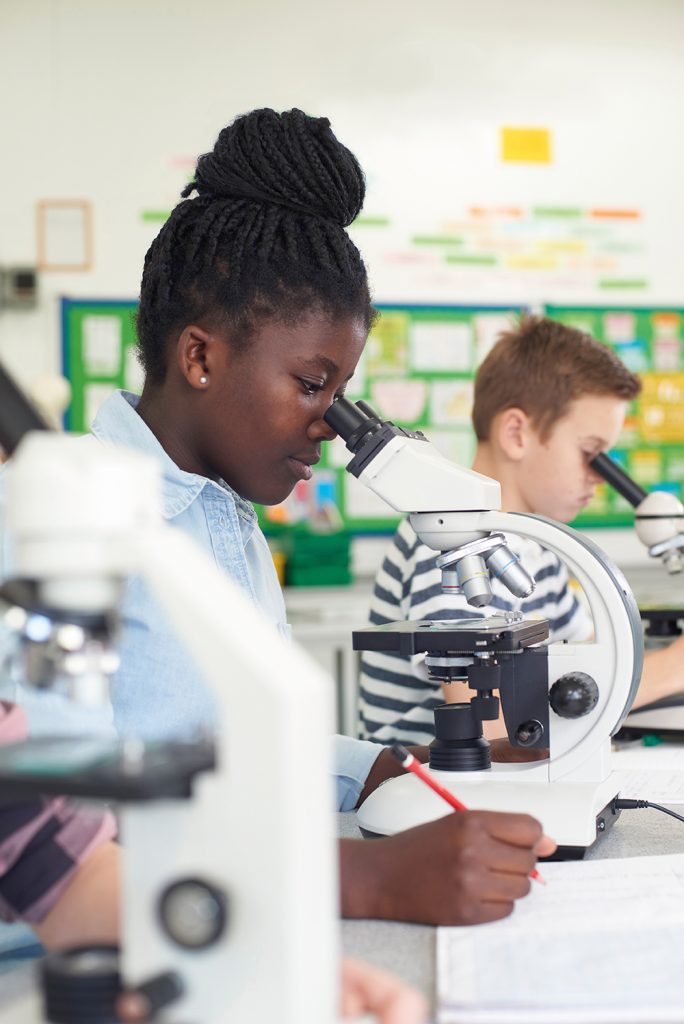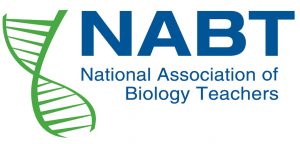The National Association of Biology Teachers
 Founded in 1938, the National Association of Biology Teachers (NABT) is an organisation of educators that promotes biology teaching, supports learning methods based on scientific principles and advocates for biology within society. In this exclusive interview, we have had the pleasure of speaking with NABT’s Executive Director, Jaclyn (Jacki) Reeves-Pepin, and President, Sharon Gusky, who discuss the varied ways in which the Association empowers educators to provide the best possible biology and life science education for all students, even in the midst of the COVID-19 pandemic.
Founded in 1938, the National Association of Biology Teachers (NABT) is an organisation of educators that promotes biology teaching, supports learning methods based on scientific principles and advocates for biology within society. In this exclusive interview, we have had the pleasure of speaking with NABT’s Executive Director, Jaclyn (Jacki) Reeves-Pepin, and President, Sharon Gusky, who discuss the varied ways in which the Association empowers educators to provide the best possible biology and life science education for all students, even in the midst of the COVID-19 pandemic.
To start, please give us a brief history of The National Association of Biology Teachers (NABT). Who established the Association, and why?
Jacki: In the years following the Scopes trial, prominent scientists and scientific organisations like AAAS were starting to publicly voice concerns that secondary science teachers were not teaching ‘organic evolution’ in their classrooms. Surveys of teachers also indicated that they weren’t teaching conservation or photosynthesis either.
On July 1, 1938, 18 biologists convened in New York City, and according to an announcement in the New York Times, they met with the express purpose to form an association ‘to encourage scientific thinking and the utilisation of the scientific method through the teaching of biology, provide a national journal, facilitate the dissemination of the biological knowledge which is most vitalising and useful to the public every day and aid biology teachers generally.’
NABT was established by biology teachers to support biology teachers, something we have been doing for the last 82 years.
NABT’s mission is to empower educators to provide the best possible biology and life science education for all students. Discuss some of the ways that the Association achieves this.
Jacki: Empowered teachers are life-long learners, so it is imperative that NABT provide opportunities to help teachers constantly reflect and improve on their own practice. We do this by providing avenues for teachers to share best-practices, innovative ideas, and research-based methods through our peer-reviewed journal, The American Biology Teacher and the NABT Professional Development Conference.
Sharon: The conference features over 100 member-referred sessions that highlight effective resources and pedagogies. Often, manuscripts lead to conference presentations and vice-versa, helping improve dissemination and adoption of the ideas.
Jacki: We also work with partners to offer workshops and seminars that help educators successfully implement current research and learner-centred teaching practices.
Another way NABT empowers educators is by celebrating their contributions to our profession through the NABT Awards Program. With the help of our generous sponsors, NABT is able to offer 12 teaching awards, five student awards, one scholarship for an educator attending graduate school, and one travel award. In addition, the NABT Outstanding Biology Teacher Award (OBTA) attempts to recognise an exceptional biology teacher in each of the 50 states, Washington DC, Canada, Puerto Rico, and overseas territories.
Sharon: Some of our most important efforts are focused on advocating for our members by being vocal supporters of science research, education, and literacy. NABT provides a number of formal position statements to help give a strong, unified voice to biology and life science educators. The statements use clear language to help articulate our views on subjects that are often viewed as controversial by society – like evolution and climate change – but are not scientifically controversial. Educators use these guiding statements to support their teaching of important topics. And the statements provide teachers backing by a nationally recognised organisation should they encounter conflicts with administrators, parents and legislators.
Jacki: There are so many resources and opportunities that NABT provides as an organisation to empower the ‘individual’ educator. But the most gratifying way we achieve NABT’s mission is by nurturing a supportive community. The leaders of NABT work to ensure the association embodies our values. We believe that improving yourself professionally is always easier if you’re doing it with a friend.
‘We believe science education should mirror how science is done. It should be evidence-based, grounded in research, iterative, and collaborative. And the ultimate goal should always be to improve understanding for learners’ – Jaclyn Reeves-Pepin

Last November, you hosted the 2019 Professional Development Conference in Chicago. How does this annual conference help NABT to fulfil its mission?
Jacki: The Professional Development Conference is immensely important to our community. As the name implies, the design of the conference is focused on professional development and learning. We look to our community of biology and life science educators to tell us what they want or need to learn about. Then our challenge is to accommodate as many high-quality sessions, workshops, speakers, posters, social events, and exhibits into a four-day timeframe as possible.
The conference is incredibly popular and attendees are recommending our event to their colleagues. As a result, the conference has experienced steady growth in attendance for the last five years. When people attend the NABT Conference, they really understand what the NABT community is all about, and how we can support them as educators.
Sharon: Because of that strong sense of community, teachers are willing to share the newest, most innovative, and often cutting-edge techniques they are using in their classrooms. They know that they will receive both supportive and honest feedback from their peers.
Jacki: Embracing the opportunity to get supportive, honest feedback is part of our culture so the NABT conference is also when our leaders and members gather to take a long, hard look at areas in need of improvement within the association.
Sharon: One of the major outcomes of the 2019 Conference is that the leaders of NABT committed to undergoing a strategic planning initiative with the express intent to improve diversity, equity, and inclusion at every level of our organisation.
The Association strongly advocates the use of evidence-based educational techniques and learner-centred approaches to teaching. Please describe an example or two of such cutting-edge techniques, and explain how you encourage biology teachers to adopt educational methods that are most effective for their classrooms and students.
Jacki: We believe science education should mirror how science is done. It should be evidence-based, grounded in research, iterative, and collaborative. And the ultimate goal should always be to improve understanding for learners.
Sharon: NABT supports the recommendations of guiding documents like the NGSS for K-12 and Vision & Change in Undergraduate Education. These tell us the ‘what’, which is content-focused, but we also need to help educators with the ‘how’. One of the best ways we can do that is by demonstrating methods that work. This could be by promoting active learning techniques and flipped classrooms. Or showing how to effectively implement CURES (course-based undergraduate research experiences) or story-lining into a curriculum.
Jacki: One of our biggest initiatives is NABT’s Introductory Biology Experience (IBEx). High school biology or introductory biology at the undergraduate level is often a student’s only exposure to STEM. NABT’s membership is 59% high school, 15% two-year college, and 18% four-year college and university. We have been working with leaders from these different levels to identify areas of overlap in content, skills, and relevance so that all students can be successful. This could mean college or career readiness for a high school student, foundational understanding for a STEM major, or improved science literacy for everyone.

What other resources do you have available for your members?
Jacki: In addition to the journal, conference, awards, and position statements mentioned above, NABT works with a diverse group of both for-profit and non-partners to create resources and opportunities for biology teachers. The life sciences advance so rapidly! The only way we can keep up is by collaborating with experts in the field.
How does NABT advocate for biology within American society?
Jacki: NABT is well-known for our commitment to science education. We have a number of formal position statements that address the ‘hows’, ‘whats’, and ‘whys’ of teaching biology and life science. Although the vast majority of NABT’s time and efforts are focused on how best to teach biology and life science, we will actively oppose attempts to misrepresent or diminish science.
In May 2019, the California State Assembly considered a bill that ‘would prohibit a pupil in any California private or public school in kindergarten and grades 1 through 12 from performing dissection’, NABT wrote a letter in opposition to the bill and also encouraged our California members to contact their representatives. Although NABT supports the ability of any student to opt-out of dissection, we felt the bill went too far. It not only used an overly broad definition of dissection to include food-grade products, it also threatened the agency of professional educators to design meaningful experiences for their students.
NABT also responds to efforts by local and state representatives who sponsor legislation to counter the teaching of ‘controversial’ topics like evolution and climate change by introducing language into state education standards that allows specific science concepts to be subjected to special consideration. The legislation seeks to permit discussions on ‘strengths and weaknesses’ or ‘alternative explanations’, and NABT’s position is that concepts like evolution and climate change are not controversial. We will challenge any effort that allows non-scientific explanations to be used to describe observable, natural phenomena in science classrooms.
NABT believes that society is best served when students understand science the same way scientists understand it, meaning it is supported by experimentation, logical analysis, evidence-based revision, and reliance on detectable and measurable data.
‘As classes moved online, there was an ‘all hands on deck’ mentality in our community and we saw increased collaboration between educators at different academic levels. NABT has always tried to encourage these interactions, but the Covid-19 pandemic showed how access to a diverse group of fellow educators is such a great asset’ – Sharon Gusky

How is the Association responding to the current global biodiversity crisis?
Jacki: Education is key here. Teachers and their students need to know about how the loss of biodiversity is personally affecting them. When we look at climate change and loss of habitat, the scale is so big it’s hard to comprehend. But when you talk about biodiversity and extinction in less abstract terms, it can help people understand how urgent we need to address this looming crisis.
Biodiversity impacts not only sustainability of ecosystems – it has implications for access to food and clean water, pharmaceutical development, the incidence of infectious pathogens. By helping students understand what’s happening and why, we hope we are giving them the tools to face this challenge head on.
In what ways have you been supporting your members throughout the COVID-19 pandemic?
Jacki: Biology teachers supporting biology teachers is very important during this challenging time. As our members moved their instruction online, it was critical that they could get just-in-time guidance and support from their peers. Some teachers only had a day to move their classes online, so they were making adjustments in real-time.
We encouraged both NABT members and non-members to join our Facebook group because of the ease of use and adoption of the forum. Members are sharing resources and setting up Zoom meet-ups, and partners and vendors are offering materials for free. NABT has made our entire journal archive free and we built a freely available resource table to capture member recommendations so teachers can more easily find useful tools.
Going into 2020, NABT is hosting our Professional Development Conference completely online so we can help keep our community safe during the ongoing Covid-19 pandemic. We’re excited by the opportunity to conduct professional learning in a new modality, and it also allows more teachers to participate in the NABT Conference from the comfort of their own homes.

More generally, what long-term changes will the COVID-19 pandemic bring to biology education?
Sharon: It is still too early in the pandemic to determine which changes will be longer term, and which will only last through the crisis. But as we approach the Fall, some changes are starting to emerge.
As classes moved online, there was an ‘all hands on deck’ mentality in our community and we saw increased collaboration between educators at different academic levels. NABT has always tried to encourage these interactions, but the Covid-19 pandemic showed how access to a diverse group of fellow educators is such a great asset.
Jacki: Recommendations for virtual tools prompted many of the early conversations, and we had high school teachers sharing the Weebly sites with university faculty, and two-year college instructors showing middle school teachers how to use Zoom more effectively. We had scientists and graduate students visit classrooms ‘virtually’. Even as the discussions move away from tools, we continue to see cross-level collaborations that focus on improving the teaching and learning of biology in an online environment and across the K-12 to college continuum. Since Covid-19, Professional Learning Communities have taken on a whole new meaning.
Sharon: NABT recognises that biology and life science cannot be effectively taught with a lecture-only approach, and so much of learning biology is actually doing biology. While remote, online, and simulated labs cannot take the place of learning hands-on lab skills, they still provide a way to introduce students to scientific practices like asking questions, analysing data, and interpreting models. We expect to see more educators fully incorporate these tools not only in their online classes, but also use them in conjunction with face-to-face instruction when they return to their campus-based classrooms.
Jacki: Of course, we also expect the Covid-19 pandemic to increase overall interest in biology and the life sciences, and especially in disciplines like virology, immunology, epidemiology, public health. The list is endless.
Biology affects people’s lives every day, not just during a pandemic, but every day. Biology teachers are here to help us make sense of this ever-changing world, and how we can stay healthy and happy in it.

Reference
https://doi.org/10.33548/SCIENTIA530
Want to republish our articles?
We encourage all formats of sharing and republishing of our articles. Whether you want to host on your website, publication or blog, we welcome this. Find out more
Creative Commons Licence
(CC BY 4.0)
This work is licensed under a Creative Commons Attribution 4.0 International License. 
What does this mean?
Share: You can copy and redistribute the material in any medium or format
Adapt: You can change, and build upon the material for any purpose, even commercially.
Credit: You must give appropriate credit, provide a link to the license, and indicate if changes were made.
More articles you may like
Grandmothers: Innovation Through Tradition
Grandmother Project – Change through Culture (GMP) is an organisation dedicated to documenting the role of grandmothers and demonstrating the effectiveness of grandmother-inclusive strategies in improving the health and well-being of women, children, and adolescents. GMP’s groundbreaking work challenges conventional wisdom to transform community-based interventions in Africa and beyond, harnessing a powerful but often overlooked resource: the wisdom and influence of grandmothers.
Dr Robert Larkin | Cultivating Change to Improve Soil Health and Increase Potato Yield
Environmental quality and food production are facing the pressing challenges of climate change and global population growth. Dr Robert Larkin from the United States Department of Agriculture-Agricultural Research Service (USDA-ARS) and a team of plant scientists developed and tested a range of crop management systems to help overcome these compounding challenges. Their work is improving soil health and increasing the yield of potato crops, contributing to the future food security of nations.
Professor Giorgio Buttazzo | Artificial Intelligence and a Crossroads for Humanity
Where do we stand with artificial intelligence? Might machines take over our jobs? Can machines become conscious? Might we be harmed by robots? What is the future of humanity? Professor Giorgio Buttazzo of Scuola Superiore Sant’Anna is an expert in artificial intelligence and neural networks. In a recent publication, he provides considered insights into some of the most pressing questions surrounding artificial intelligence and humanity.
Dr Ralf Adam | New Technologies Shaping the Future of Oral Hygiene
Understanding the efficiency of various toothbrush technologies is essential for achieving optimal oral health. Dr Ralf Adam, who leads a dedicated team at Procter & Gamble in Germany, is keen to investigate the complexities of these technologies. His team have provided new insights into the best toothbrush types for plaque removal and the maintenance of gum health. By highlighting the importance of informed oral care decisions and ongoing investigations, this vital research works towards ensuring everyone can achieve a brighter, healthier smile.




